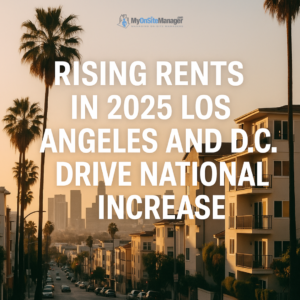U.S. single‑family rent prices are on the rise again, with Cotality’s March 2025 Single‑Family Rent Index (SFRI) reporting a 2.9% year‑over‑year increase. This marks the third consecutive month of accelerating rent growth, signaling that the softening rental market seen in late 2024 may be firmly in the rearview mirror.
“After hitting a low point in December 2024, single‑family rent growth has started climbing again,” said Molly Boesel, senior principal economist at Cotality. “In markets with less new construction, rents are growing faster as demand remains strong.”
National Rental Trends: Growth Across the Board
The 2.9% annual increase in March slightly outpaced the 2.8% rise recorded a year earlier, confirming a return to upward momentum. Both attached and detached single‑family homes registered identical annual gains of 2.8%, illustrating that demand for different rental property types is consistent across the market.
Key highlights include:
-
High‑end rentals (priced 25% above the regional median) grew 3.5% year‑over‑year, accelerating from 2.9% in March 2024.
-
Low‑end rentals (priced 25% below the regional median) saw slower growth at 2.1%, a deceleration from 2.7% last year.
-
This widening gap between high- and low-end rental growth suggests that luxury rental demand remains robust, while affordability constraints are impacting the lower end of the market.
Metro Performance: Los Angeles Takes the Top Spot
When looking at specific metro areas, the rental market continues to be shaped by regional supply and demand dynamics:
-
Los Angeles recorded the largest rent increase at 6.8% year‑over‑year. Analysts attribute this surge to housing disruptions following the January 2025 wildfires, which displaced residents and created tighter rental competition.
-
Washington, D.C. followed closely with a 6.0% increase, reflecting strong employment trends and limited inventory.
-
Dallas experienced a rare 0.5% decline in single‑family rents. This drop is linked to an influx of new rental supply, giving tenants greater negotiating power.
-
Miami posted a modest 1.5% increase, significantly lower than its pandemic-era double-digit spikes, as new developments stabilize the market.
Market Forces at Play
Why are rents rising again?
The resurgence of rental growth can be tied to multiple factors:
-
Economic resilience: Despite higher interest rates, job markets in many U.S. metros remain stable, driving continued rental demand.
-
Limited homebuying options: Many would-be homebuyers remain renters due to high mortgage rates and home prices.
-
New supply dynamics: While some metros like Dallas benefit from high construction activity, others face a rental inventory squeeze, causing upward price pressure.
Expert Insights
Boesel’s analysis highlights the importance of regional supply in determining rent trends. “Markets with significant new construction, such as Dallas and parts of Florida, are seeing slower or even negative growth. But in regions where supply is limited—especially those affected by recent natural disasters or economic constraints—rents are climbing faster.”
Looking Ahead
Cotality’s data suggests that the rental market has shifted into a phase of moderate growth. While nationwide gains remain far below the double-digit spikes of 2022, the current trend shows steady upward movement. For renters, this means:
-
Tighter competition in high-demand metros.
-
Stable or slower growth in markets with heavy new construction.
-
Luxury segment momentum, which could set pricing trends across the broader market.
Key Takeaways
-
U.S. single‑family rent prices rose 2.9% in March 2025, continuing a three-month growth streak.
-
Los Angeles (6.8%) and Washington, D.C. (6.0%) saw the largest gains.
-
Dallas is the only major metro to record a decline, with rents falling 0.5%.
-
The gap between high‑end and low‑end rental growth is widening, driven by strong demand in the luxury segment.
Source: HousingWire – “Cotality: Single-family rent prices rise 2.9% in March 2025”

